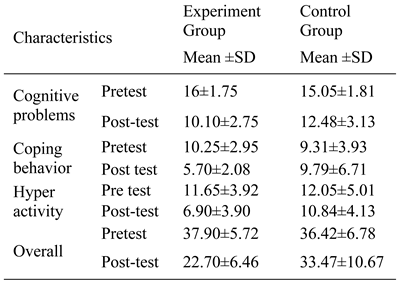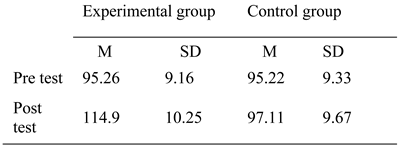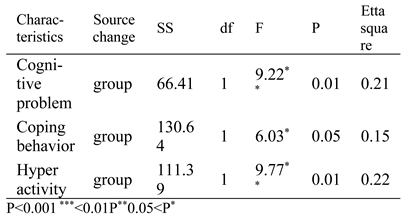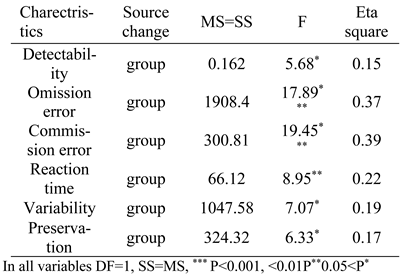Effect of a Visual Tracking Intervention on Attention and Behavior of Children with Attention Deficit Hyperactivity Disorder
Abstract
Introduction
Methods
Participants
Design
Materials
Wechsler Intelligence Scale for Children
Continuous Performance Test
Visual-Motor Skills Test-Revised
Procedure
- a)
- Isolation of neck and eye movement (head stabilization) to promote stability of posture, because visual perception in ADHD is affected by fidgeting and hyperactivity.
- b)
- Promotion of awareness about eye movements and pursuit by the utilization of variation in the orientation and direction components in exercises.
- c)
- Promotion of time perception and patience, because children with ADHD suffer from time aversion and temporal dysregulation that emerges as commission errors in sustained attention tests, for example, the CPT (continuous performance test).
- d)
- Promotion of attention to the environment and working memory to give priority and value to important items and disregard unwanted stimuli to decrease distractions.
- Isolated neck and eye movement (tracking and pursuit) together with vestibular exercises on a tilt board in a standing position: In these tasks, the child holds their head in a fixed position and follows a moving target (laser pointer), reporting what stimuli suddenly appear on a screen and where they were located.
- Tracking simple and colourful / unicolor /complicated lines in vertical, horizontal or diagonal orientation respectively with a laser pointer: The child holds their head in a fixed position (while standing) and follows lines with a laser pointer based on verbal instructions from the therapist related to stimulus position and speed.
- Number-based saccadic task with presentationspeed variation (slow, medium, and fast): Numbers randomly appear at the center of a screen and children are asked to name the numbers as soon as they see them.
- Reporting on images during distraction: Four colored light bulbs are automatically switched on and off every 5 s at 4 corners of a screen. At the same time, pictures are displayed at different orientations on the screen and the child has to name the picture or search in the picture for the requested component. During this activity, the child's head is held in a fixed position by a chin board.
- Search of the environment by the torch in darkness: The therapist places cards and toys in the room including pasting pictures on the walls and then asks the child to find them in the dark with a torch by a segmental and categorical active search.
- Shadow play with the torch: the child must coordinate body, head, and eye movements as they cast their shadow or the shadow of toys and instruments on the board, following the therapist's instructions.
- Fixation practice: The child has a laser pointer in their hand and a headlight attached to their head. The therapist asks the child to hold both lights on a single image or given points and items in a presented picture.
- Two light configurations: The child's head is held in a fixed position by a chin board. The therapist asks the child to move their eyes in the direction of a light and follow the direction and speed of the light with a torch in a maze (simple, curved and zigzag pathway). The light position is randomized with respect to side.
- Simple to complex distance drawing by use of a video projector projecting images onto a screen: In this task, a video camera is situated under a table, transferring the image of what a child is drawing on their blackboard to screen. The child is only allowed to look at the screen to complete the task (drawing or completing a picture) on the blackboard while unable to see their own hand.
- Visual-motor training using the Nintendo Wii Kinect game: Using the Wii fit plus series with a balance board (beginner and intermediate level).
Results
Discussion
- A)
- Visual-spatial skills
- B)
- Visual-motor skills or visual-motor integration (Goldstand, Koslowe, & Parush, 2005)(Goldstand, Koslowe et al. 2005)
Limitations
Ethics and Conflict of Interest
Acknowledgments
References
- AnaCubillo, R. A review of fronto-striatal and fronto-cortical brain abnormalities in children and adults with Attention Deficit Hyperactivity Disorder (ADHD) and new evidence for dysfunction in adults with ADHD during motivation and attention. Cortex 2012, 194–215. [Google Scholar]
- Armstrong, I.; Munoz, D. Inhibitory control of eye movements during oculomotor countermanding in adults with attention-deficit hyperactivity disorder. Experimental Brain Research 2003, 152(4), 444–452. [Google Scholar]
- Aron, A. R.; Robbins, T. W.; Poldrack, R. A. Inhibition and the right inferior frontal cortex. Trends in Cognitive Sciences 2004, 8(4), 170–177. [Google Scholar]
- Asiry, O.; Shen, H.; Calder, P. Extending attention span of ADHD children through an eye tracker directed adaptive user interface. In Paper presented at the Proceedings of the ASWEC 2015 24th Australasian Software Engineering Conference; 2015. [Google Scholar]
- Aylward, E. H.; Reiss, A. L.; Reader, M. J.; Singer, H. S.; Brown, J. E.; Denckla, M. B. Basal ganglia volumes in children with attention-deficit hyperactivity disorder. Journal of Child Neurology 1996, 11(2), 112–115. [Google Scholar] [CrossRef] [PubMed]
- Ayres, A. J.; Robbins, J. Sensory integration and the child: Understanding hidden sensory challenges; Western Psychological Services, 2005. [Google Scholar]
- Bailey, T.; Joyce, A. The role of the thalamus in ADHD symptomatology and treatment. Applied Neuropsychology: Child 2015, 4(2), 89–96. [Google Scholar] [PubMed]
- Barkley, R. A. Behavioral inhibition, sustained attention, and executive functions: constructing a unifying theory of ADHD. Psychological Bulletin 1997, 121(1), 65. [Google Scholar]
- Bushnell, M. C.; Goldberg, M. E.; Robinson, D. L. Behavioral enhancement of visual responses in monkey cerebral cortex. I. Modulation in posterior parietal cortex related to selective visual attention. Journal of Neurophysiology 1981, 46(4), 755–772. [Google Scholar]
- Bylsma, F.; Pivik, R. The effects of background illumination and stimulant medication on smooth pursuit eye movements of hyperactive children. Journal of Abnormal Child Psychology 1989, 17(1), 73–90. [Google Scholar]
- Cairney, S.; Maruff, P.; Vance, A.; Barnett, R.; Luk, E.; Currie, J. Contextual abnormalities of saccadic inhibition in children with attention deficit hyperactivity disorder. Experimental Brain Research 2001, 141(4), 507–518. [Google Scholar] [CrossRef]
- Castellanos, F. X.; Marvasti, F. F.; Ducharme, J. L.; Walter, J. M.; Israel, M. E.; Krain, A.; Hommer, D. W. Executive function oculomotor tasks in girls with ADHD. Journal of the American Academy of Child & Adolescent Psychiatry 2000, 39(5), 644–650. [Google Scholar]
- Chelune, G. J.; Ferguson, W.; Koon, R.; Dickey, T. Frontal lobe disinhibition in attention deficit disorder. Child Psychiatry & Human Development 1986, 16(4), 221–234. [Google Scholar]
- Coallier, M.; Rouleau, N.; Bara, F.; Morin, M. F. Visual-motor skills performance on the Beery-VMI: A study of Canadian kindergarten children. Open Journal of Occupational Therapy 2014, 2(2), 4. [Google Scholar] [CrossRef]
- Durston, S.; van Belle, J.; de Zeeuw, P. Differentiating frontostriatal and fronto-cerebellar circuits in attention-deficit/hyperactivity disorder. Biological Psychiatry 2011, 69(12), 1178–1184. [Google Scholar] [PubMed]
- Epstein, J. N.; Erkanli, A.; Conners, C. K.; Klaric, J.; Costello, J. E.; Angold, A. Relations between continuous performance test performance measures and ADHD behaviors. Journal of Abnormal Child Psychology 2003, 31(5), 543–554. [Google Scholar] [CrossRef]
- Goldstand, S.; Koslowe, K. C.; Parush, S. Vision, Visual-Information Processing, and Academic Performance Among Seventh-Grade Schoolchildren: A More Significant Relationship Than We Thought? American Journal of Occupational Therapy 2005, 59((4)), 377–389. [Google Scholar]
- Goto, Y.; Hatakeyama, K.; Kitama, T.; Sato, Y.; Kanemura, H.; Aoyagi, K.; Aihara, M. Saccade eye movements as a quantitative measure of frontostriatal network in children with ADHD. Brain and Development 2010, 32(5), 347–355. [Google Scholar] [CrossRef]
- Jeannerod, M.; Arbib, M. A.; Rizzolatti, G.; H., S. Grasping objects: the cortical mechanisms of visuomotor transformation. Trends in Neurosciences 18 1995, 314–320. [Google Scholar] [CrossRef]
- Johnston, B. A.; Mwangi, B.; Matthews, K.; Coghill, D.; Konrad, K.; Steele, J. D. Brainstem abnormalities in attention deficit hyperactivity disorder support high accuracy individual diagnostic classification. Human Brain Mapping 2014, 35(10), 5179–5189. [Google Scholar]
- Johnstone, J. A.; Ramon, M. Perceptual-motor activities for children: An evidence-based guide to building physical and cognitive skills; Human Kinetics, 2011. [Google Scholar]
- Kandel, E. R.; Schwartz, J. H.; Jessell, T. M.; Biochemistry, D. o.; Jessell, M. B. T.; Siegelbaum, S.; Hudspeth, A. Principles of neural science; McGraw-hill New York, 2000; Vol. 4. [Google Scholar]
- Karcher, M. J. Connectedness and school violence: A framework for developmental interventions. Handbook of school violence 2004, 7–42. [Google Scholar]
- Krain, A. L.; Castellanos, F. X. Brain development and ADHD. Clinical Psychology Review 2006, 26(4), 433–444. [Google Scholar] [CrossRef]
- Leigh, R. J.; Zee, D. S. The neurology of eye movements; Oxford University Press, USA, 2015; Vol. 90. [Google Scholar]
- Lijffijt, M.; Kenemans, J. L.; Verbaten, M. N.; van Engeland, H. A meta-analytic review of stopping performance in attention-deficit/hyperactivity disorder: deficient inhibitory motor control? Journal of Abnormal Psychology 2005, 114(2), 216. [Google Scholar] [CrossRef] [PubMed]
- Lijffijt, M.; Kenemans, J. L.; Verbaten, M. N.; van Engeland, H. A meta-analytic review of stopping performance in attention-deficit/hyperactivity disorder: deficient inhibitory motor control? Journal of Abnormal Psychology 2005, 114(2), 216. [Google Scholar] [CrossRef]
- Mahone, E. M. ADHD: Volumetry, motor, and oculomotor functions. In Behavioral Neuroscience of Attention Deficit Hyperactivity Disorder and Its Treatment; Springer, 2011; pp. 17–47. [Google Scholar]
- Martel, M.; Nikolas, M.; Nigg, J. T. Executive Function in Adolescents With ADHD. Journal of the American Academy of Child & Adolescent Psychiatry 2007, 46(11), 1437–1444. [Google Scholar]
- Moore, T.; Fallah, M. Microstimulation of the frontal eye field and its effects on covert spatial attention. Journal of Neurophysiology 2004, 91(1), 152–162. [Google Scholar] [CrossRef] [PubMed]
- Mostofsky, S.; Lasker, A.; Cutting, L.; Denckla, M.; Zee, D. Oculomotor abnormalities in attention deficit hyperactivity disorder. A preliminary study. 1. American Journal of Ophthalmology 2002, 133(1), 176. [Google Scholar] [CrossRef]
- Mostofsky, S. H.; Lasker, A.; Cutting, L.; Denckla, M.; Zee, D. Oculomotor abnormalities in attention deficit hyperactivity disorder A preliminary study. Neurology 2001, 57(3), 423–430. [Google Scholar] [CrossRef] [PubMed]
- Munoz, D. P.; Armstrong, I. T.; Hampton, K. A.; Moore, K. D. Altered control of visual fixation and saccadic eye movements in attention-deficit hyperactivity disorder. Journal of Neurophysiology 2003, 90(1), 503–514. [Google Scholar] [CrossRef]
- Munoz, D. P.; Everling, S. Look away: the anti-saccade task and the voluntary control of eye movement. Nature Reviews Neuroscience 2004, 5(3), 218–228. [Google Scholar] [CrossRef]
- Nee, D. E.; Jahn, A.; Brown, J. W. Prefrontal Cortex Organization: Dissociating Effects of Temporal Abstraction, Relational Abstraction, and Integration with fMRI. Cerebral Cortex 2013, 24(9), 2377–2387. [Google Scholar] [CrossRef]
- Nigg, J. T. Is ADHD a disinhibitory disorder? Psychological Bulletin 2001, 127(5), 571. [Google Scholar] [CrossRef]
- Overton, P. G. Collicular dysfunction in attention deficit hyperactivity disorder. Medical Hypotheses 2008, 70(6), 1121–1127. [Google Scholar] [PubMed]
- Pishyareh, E.; Tehrani-Doost, M.; Mahmoodi-Gharaie, J.; Khorrami, A.; Joudi, M.; Ahmadi, M. Attentional bias towards emotional scenes in boys with attention deficit hyperactivity disorder. Iranian Journal of Psychiatry 2012, 7(2), 93. [Google Scholar]
- Pishyareh, E.; Tehrani-Doost, M.; Mahmoodi-Gharaie, J.; Khorrami, A.; Rahmdar, S. R. A comparative study of sustained attentional bias on emotional processing in ADHD children to pictures with eye-tracking. Iranian Journal of Child Neurology 2015, 9(1), 64. [Google Scholar]
- Polanczyk, G. V.; Willcutt, E. G.; Salum, G. A.; Kieling, C.; Rohde, L. A. ADHD prevalence estimates across three decades: an updated systematic review and meta-regression analysis. International Journal of Epidemiology 2014, 43(2), 434–442. [Google Scholar]
- Rapport, M. D.; Bolden, J.; Kofler, M. J.; Sarver, D. E.; Raiker, J. S.; Alderson, R. M. Hyperactivity in boys with attention-deficit/hyperactivity disorder (ADHD): a ubiquitous core symptom or manifestation of working memory deficits? Journal of abnormal Child Psychology 2009, 37(4), 521–534. [Google Scholar]
- Rayner, K. The 35th Sir Frederick Bartlett Lecture: Eye movements and attention in reading, scene perception, and visual search. Quarterly Journal of Experimental Psychology 2009, 62(8), 1457–1506. [Google Scholar]
- Ross, R. G.; Hommer, D.; Breiger, D.; Varley, C.; Radant, A. Eye movement task related to frontal lobe functioning in children with attention deficit disorder. Journal of the American Academy of Child & Adolescent Psychiatry 1994, 33(6), 869–874. [Google Scholar]
- Rosvold, H. E.; Mirsky, A. F.; Sarason, I.; Bransome, E. D. J.; Beck, L. H. A continuous performance test of brain damage. Journal of Consulting Psychology 1956, 20((5)), 343–350. [Google Scholar]
- Rubia, K.; Overmeyer, S.; Taylor, E.; Brammer, M.; Williams, S. C.; Simmons, A.; Bullmore, E. T. Hypofrontality in attention deficit hyperactivity disorder during higher-order motor control: a study with functional MRI. American Journal of Psychiatry 1999, 156(6), 891–896. [Google Scholar] [CrossRef]
- Rubia, K.; Smith, A. B.; Brammer, M. J.; Toone, B.; Taylor, E. Abnormal brain activation during inhibition and error detection in medication-naive adolescents with ADHD. American Journal of Psychiatry 2005, 162(6), 1067–1075. [Google Scholar] [CrossRef]
- Satterfield, J. H.; Schell, A. M.; Nicholas, T. W.; Satterfield, B. T.; Freese, T. E. Ontogeny of selective attention effects on event-related potentials in attention-deficit hyperactivity disorder and normal boys. Biological Psychiatry 1990, 28(10), 879–903. [Google Scholar] [CrossRef]
- Shiels, K.; Hawk, L. W. Self-regulation in ADHD: The role of error processing. Clinical Psychology Review 2010, 30(8), 951–961. [Google Scholar]
- Sinclair, M. Pediatric massage therapy; Lippincott Williams & Wilkins, 2004. [Google Scholar]
- Stray, L. L.; Stray, T.; Iversen, S.; Ruud, A.; Ellertsen, B.; Tønnessen, F. E. The Motor Function Neurological Assessment (MFNU) as an indicator of motor function problems in boys with ADHD. Behavioral and Brain Functions 2009, 5(1), 22. [Google Scholar] [CrossRef]
- Stuphorn, V. Neuroeconomics: cardinal utility in the orbitofrontal cortex? Current Biology 2006, 16(15), R591–R593. [Google Scholar][Green Version]
- Swainson, R.; Cunnington, R.; Jackson, G. M.; Rorden, C.; Peters, A. M.; Morris, P. G.; Jackson, S. R. Cognitive control mechanisms revealed by ERP and fMRI: evidence from repeated task-switching. Journal of Cognitive Neuroscience 2003, 15(6), 785–799. [Google Scholar] [CrossRef]
- Treue, S. Visual attention: the where, what, how and why of saliency. Current Opinion in Neurobiology 2003, 13(4), 428–432. [Google Scholar]
- Wijetunge, G; Dayasena, J; Kulathilake, I; Ratnathilake, P; Y., N. Prevalence of comorbidities in children with attention deficit and hyperactivity disorder at Lady Ridgeway Hospital for Children, Sri Lanka. Sri Lanka Journal of Child Health 2015, 44((2)), 77. [Google Scholar] [CrossRef]
- Wolraich, M.; Brown, L.; Brown, R. T.; DuPaul, G.; Earls, M.; Feldman, H. M.; Visser, S. ADHD: clinical practice guideline for the diagnosis, evaluation, and treatment of attention-deficit/hyperactivity disorder in children and adolescents. Pediatrics 2011, 128(5), 1007–1022. [Google Scholar]
- Zee, D. S.; Leigh, R. J.; Mathieu-Millaire, F. Cerebellar control of ocular gaze stability. Annals of Neurology 1980, 7(1), 37–40. [Google Scholar] [CrossRef]






Copyright © 2020. This article is licensed under a Creative Commons Attribution 4.0 International License.
Share and Cite
Janmohammadi, S.; Haghgoo, H.A.; Farahbod, M.; Overton, P.G.; Pishyareh, E. Effect of a Visual Tracking Intervention on Attention and Behavior of Children with Attention Deficit Hyperactivity Disorder. J. Eye Mov. Res. 2019, 12, 1-11. https://doi.org/10.16910/jemr.12.8.6
Janmohammadi S, Haghgoo HA, Farahbod M, Overton PG, Pishyareh E. Effect of a Visual Tracking Intervention on Attention and Behavior of Children with Attention Deficit Hyperactivity Disorder. Journal of Eye Movement Research. 2019; 12(8):1-11. https://doi.org/10.16910/jemr.12.8.6
Chicago/Turabian StyleJanmohammadi, Shiva, Hojjat Allah Haghgoo, Mojgan Farahbod, Paul G. Overton, and Ebrahim Pishyareh. 2019. "Effect of a Visual Tracking Intervention on Attention and Behavior of Children with Attention Deficit Hyperactivity Disorder" Journal of Eye Movement Research 12, no. 8: 1-11. https://doi.org/10.16910/jemr.12.8.6
APA StyleJanmohammadi, S., Haghgoo, H. A., Farahbod, M., Overton, P. G., & Pishyareh, E. (2019). Effect of a Visual Tracking Intervention on Attention and Behavior of Children with Attention Deficit Hyperactivity Disorder. Journal of Eye Movement Research, 12(8), 1-11. https://doi.org/10.16910/jemr.12.8.6



